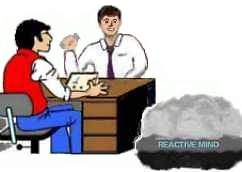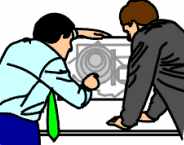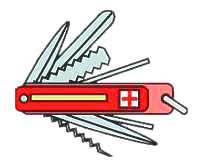Dating and Locating |
||||||||
|
Dating is the action the auditor takes to help the pc spot the exact time something happened. Locating is the action the auditor takes to help the pc spot the exact place something happened. The essence of Date/Locate is to bring the pc out of a past incident and bring him into present time by erasing the Date by spotting it. And then erasing the Location by spotting it. The pc was out of the present (PT) and fixed by both date and location of the incident or event. Understand this simple point and you will have no trouble with Date/Locate or have much need for a rote procedure. A number of his attention units were fixated in the past - still trying to resolve a past event or incident. It can be an engramic incident, which left the pc frozen in terror or overwhelmed by the emotional content or a threat to his survival at the time. But the process itself is simply to Date and Locate anything on the pc's track - near or far, good or bad.
It is a fast and highly precise action. It is a very direct way of dealing with such images, events and incidents. It needs to be done smoothly and with good TR's. The results can be very swift and remarkable. Uses It can be used as a special rehab process. In this case you pinpoint a release point or win in the pc's auditing and put any wondering in his mind to rest. But you can also handle moments of loss and trauma and unstick the pc from various other stuck points on the Time Track. It is also used to correct wrong dates and locations found in earlier auditing. The auditor will in many processes ask casually when and where something took place. Sometimes pc's can get hung up on that if it was wrong in some way. In all these instances the pc will have his attention hung up on stuck points and finding the exact 'when' and 'where' will unstick him from them. Background
With the Locate step you handle the stuck viewpoint of location. That is exactly where the pc was and viewed it from when it happened. You may ask: If you have dated an incident to a
Blow, is there anything left to blow on the Locate step? By dating and locating, getting the exact time and place a specific event happened, the pc is able to blow the mass and energy connected with the incident. Taken to Blow This definition must be understood by both auditor and pc. It is cleared with the pc before beginning the Date/Locate steps. Have the pc demo it, using a demo kit as needed. A blow is a definite manifestation. Vital data for the auditor is that the pc must say "Something blew" or "It disappeared" or "It's gone" or "It vanished," not simply "I feel lighter. " It can also be demonstrated by the
auditor this way: The auditor puts his hand on the pc's arm. The pc will
feel the light pressure. Then the auditor removes his hand and the pc will
notice the lack of pressure. That demonstrates a Blow. A pc can be made more dependent on the Meter or can be made less dependent of the Meter. This depends upon the auditor. If the auditor "asks the Meter" all the time he and the pc get more and more dependent. If the pc's case is improving he will become more in-dependent of the Meter. That is what you want to see. The rule is: Use the Meter to find dates - but only after the pc has been unable to come up with the date. The same principle applies to the Locate steps.
First you simply ask the pc, "When was it?". He may tell you in terms of "years ago" or "weeks ago." Or he may say "It was 1792" or "It was the 24th of May 1492." Or he may come up with an earlier track system of dating. Either way, you take it and if he has said "Exactly at Midnight on March 12, 1918" you don't then ask "How many years ago?" He basically just told you and your question would be a form of not accepting his data by trying to alter the dating system the pc is using. Rule: You accept and use the dating system the pc is using. It is a very remarkable thing that a pc can figure out in years when something happened earlier than this planet. The pc has some sort of mental computer that can do this. But there is no point in trying to get the pc to convert a date to some other system. When the pc has it the auditor sticks to the pc's exact statement. He calls it back by that system (time ago or by date). To call it back is an indication. You use the pc's exact wording when doing that.
Meter-check this:
Location Rule: You accept and use the distance system the pc is using. And once the pc has stated the distance the auditor sticks to the pc's exact statement. He calls it back by that system. To call it back is an indication. You use the pc's exact wording when doing that.
Locating Step Sometimes you get the blow early in the procedure, on the direction step alone or on the pc realizing it happened somewhere else, or "not here" or "Australia" or whatever. The auditor must be alert for the BD and F/N and ask the pc if it blew. To go on is an overrun and messy as it already blew. If you don't get a blow on finding the direction and distance, you will usually get a blow on calling the location back to the pc as an indication. If not, suspect an error in the direction or distance - or the auditor altered it in calling it back. In locating the auditor is getting the past physical location of the incident. The auditor gets the direction, distance, what galaxy, star, planet, country, etc. In this way he pinpoints it to the exact location in space where it happened. In drilling and doing the procedure, remember this: it is not done rotely; one uses the questions that apply. For example, if it occurred "next door" one would not ask "What planet?". If the pc on the dating step has said it's "two years ago" you wouldn't go on and ask "What galaxy?" when locating the same incident, of course. If the incident happened outside a town in the open you wouldn't ask what city, house, street or room, either. You use common sense and ask the questions that apply. The auditor does not try to run
incidents or Engrams at the same time he is doing the Locate step. It is
simply location. Where? What? How far? If there is no instant blow when the location is fully spotted and it seems correct, the location is called back to the pc. It usually blows when it is called back to the pc after it is known.
|
||||||||














